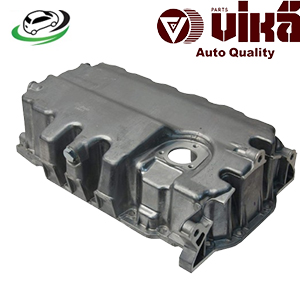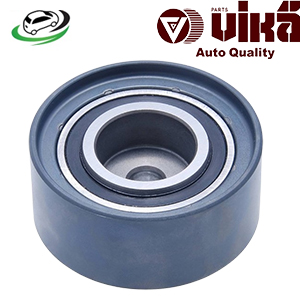-5%
Get AUDI A3 (8P1)/ A3 Sportback (8PA) / VW Golf V (1K1)/ Jetta III (1K2)/ Passat B6 (3C2)/ Touaran (1T1 1T2) Pulley Idler Timing Belt 03G109244A
The timing belt system is a crucial component of an internal combustion engine, responsible for synchronizing the rotation of the crankshaft and camshaft. At the heart of this system lies the idler pulley, which plays a vital role in maintaining proper tension and alignment of the timing belt. This guide will explore the function, design, maintenance, and common issues related to the idler pulley in timing belt systems.
1. What is a Pulley Idler Timing Belt?
The pulley idler timing belt, commonly referred to as the timing belt idler pulley, is a component of the timing belt system that helps manage the tension and alignment of the timing belt. The timing belt itself is a toothed belt that connects the crankshaft and camshaft, ensuring that they rotate in sync for optimal engine performance. The idler pulley guides and maintains the tension of the timing belt, preventing it from slipping or becoming loose during engine operation.
2. Function of the Idler Pulley
A. Tension Management
One of the primary functions of the idler pulley is to maintain proper tension on the timing belt. A correctly tensioned timing belt is crucial for ensuring that the engine’s timing remains accurate. If the belt is too loose, it can slip, leading to misalignment between the crankshaft and camshaft, resulting in poor engine performance, increased wear, or catastrophic engine failure.
B. Belt Alignment
The idler pulley also serves to guide the timing belt along its proper path. Proper alignment is essential to ensure that the belt engages with the teeth of the sprockets on both the crankshaft and camshaft. Misalignment can cause premature wear on the belt and associated components.
C. Noise Reduction
The idler pulley can also help reduce noise in the timing belt system. By providing a smooth surface for the belt to run against, it minimizes vibrations and noise that can occur due to belt movement. This can contribute to a quieter engine operation.
3. Importance of the Idler Pulley
A. Engine Performance
The idler pulley plays a critical role in maintaining engine performance. A properly tensioned and aligned timing belt ensures that the engine’s valves open and close at the correct times, maximizing combustion efficiency and power output.
B. Preventing Engine Damage
Failure of the timing belt system can lead to severe engine damage. If the timing belt slips or breaks due to improper tension or alignment, it can cause the pistons to collide with the valves, leading to bent valves, damaged pistons, and potentially catastrophic engine failure. The idler pulley helps prevent these issues by ensuring the timing belt remains properly tensioned and aligned.
C. Extended Component Life
By maintaining proper tension and alignment, the idler pulley helps extend the life of the timing belt, crankshaft, and camshaft. This not only saves on repair costs but also enhances the overall reliability of the engine.
4. Design and Construction of Idler Pulleys
A. Materials
Idler pulleys are typically made from durable materials such as reinforced plastic, aluminum, or steel. The choice of material depends on the specific application and the expected load on the pulley. High-performance engines may utilize idler pulleys made from lightweight yet robust materials to minimize weight while maintaining strength.
B. Design Features
- Bearings: Most idler pulleys are equipped with bearings that allow for smooth rotation. These bearings are designed to handle the radial loads and provide low friction for efficient operation.
- Belt Groove: The groove on the idler pulley is designed to match the teeth of the timing belt. This ensures a secure fit and helps prevent the belt from slipping off during operation.
- Surface Finish: The surface of the idler pulley is usually treated or finished to reduce wear and friction, enhancing its longevity.
C. Types of Idler Pulleys
- Fixed Idler Pulleys: These pulleys are stationary and provide a fixed point for the timing belt to wrap around. They do not adjust tension and rely on other components to maintain proper belt tension.
- Adjustable Idler Pulleys: Some idler pulleys are designed to be adjustable, allowing for fine-tuning of belt tension during installation or maintenance. This can be particularly beneficial in high-performance applications.
5. Common Issues with Idler Pulleys
A. Wear and Tear
Like any mechanical component, idler pulleys can wear out over time. The bearings can become worn or damaged, leading to increased friction and noise. A worn idler pulley can also result in improper tensioning of the timing belt.
B. Belt Misalignment
If the idler pulley becomes misaligned or damaged, it can lead to belt misalignment. This can cause the timing belt to wear unevenly, resulting in premature failure.
C. Noise
A failing idler pulley may produce noise, such as grinding or squeaking sounds. This can indicate that the bearings are worn or that the pulley is misaligned.
D. Breakage
In severe cases, an idler pulley can break, leading to sudden loss of tension on the timing belt. This can result in immediate engine damage if the timing is disrupted.
6. Maintenance of Idler Pulleys
A. Regular Inspections
Routine inspections of the timing belt system, including the idler pulley, are crucial for identifying potential issues before they become serious. Check for signs of wear, such as fraying or cracking of the timing belt and any noise or play in the idler pulley.
B. Replacing the Timing Belt
When replacing the timing belt, it is generally recommended to replace the idler pulley as well, especially if it shows signs of wear. This is a preventive measure that can help avoid future problems.
C. Tension Adjustment
If the idler pulley is adjustable, ensure that the tension is set correctly during installation. Refer to the manufacturer’s specifications for the appropriate tension settings.
D. Lubrication
If the idler pulley is equipped with grease fittings or requires lubrication, ensure that it is properly lubricated to reduce friction and wear.
7. Conclusion
The pulley idler timing belt is a vital component of an engine’s timing system, responsible for maintaining proper tension and alignment of the timing belt. Its role in ensuring accurate engine timing, preventing wear, and prolonging component life cannot be overstated. Regular maintenance and timely replacement are essential for ensuring the idler pulley functions correctly, helping to prevent catastrophic engine damage and ensuring optimal performance.
Understanding the design, function, and maintenance of the idler pulley can empower vehicle owners and technicians to keep their engines running smoothly and efficiently. By prioritizing the health of the timing belt system and addressing issues promptly, you can protect your engine and enhance its performance for years to come.
Follow us on Facebook for more parts.




Reviews
Clear filtersThere are no reviews yet.